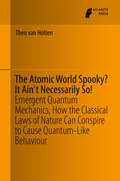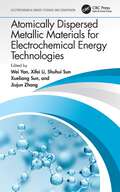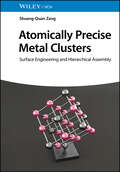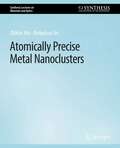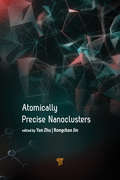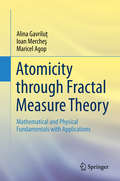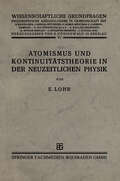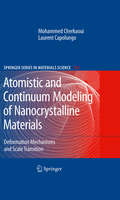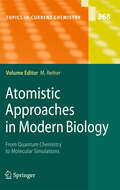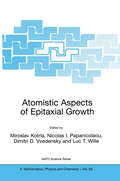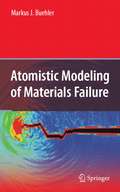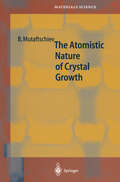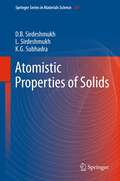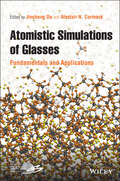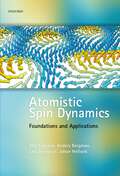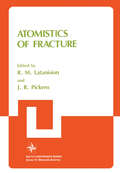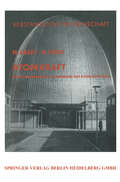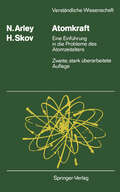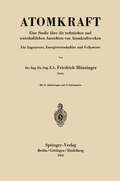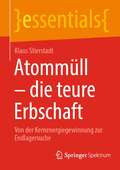- Table View
- List View
The Atomic World Spooky? It Ain't Necessarily So!: Emergent Quantum Mechanics, How the Classical Laws of Nature Can Conspire to Cause Quantum-Like Behaviour
by Theo van HoltenThe present book takes the discovery that quantum-like behaviour is not solely reserved to atomic particles one step further. If electrons are modelled as vibrating droplets instead of the usually assumed point objects, and if the classical laws of nature are applied, then exactly the same behaviour as in quantum theory is found, quantitatively correct! The world of atoms is strange and quantum mechanics, the theory of this world, is almost magic. Or is it? Tiny droplets of oil bouncing round on a fluid surface can also mimic the world of quantum mechanics. For the layman - for whom the main part of this book is written - this is good news. If the everyday laws of nature can conspire to show up quantum-like phenomena, there is hope to form mental pictures how the atomic world works. The book is almost formula-free, and explains everything by using many sketches and diagrams. The mathematical derivations underlying the main text are kept separate in a -peer reviewed - appendix. The author, a retired professor of Flight Mechanics and Propulsion at the Delft University of Technology, chose to publish his findings in this mixed popular and scientific form, because he found that interested laymen more often than professional physicists feel the need to form visualisations of quantum phenomena.
Atomically Dispersed Metallic Materials for Electrochemical Energy Technologies (Electrochemical Energy Storage and Conversion)
by Xifei Li Shuhui Sun Xueliang Sun Jiujun Zhang Wei YanAtomically dispersed metallic materials (ADMMs) are the most advanced materials used in energy conversion and storage devices to improve their performance for portable electronics, electric vehicles, and stationary power stations. Atomically Dispersed Metallic Materials for Electrochemical Energy Technologies aims to facilitate research and development of ADMMs for applications in electrochemical energy devices. It provides a comprehensive description of the science and technology of ADMMs, including material selection, synthesis, characterization, and their applications in fuel cells, batteries, supercapacitors, and H2O/CO2/N2 electrolysis to encourage progress in commercialization of these clean energy technologies. Offers a comprehensive introduction to various types of ADMMs, their fabrication and characterization, and how to improve their performance Analyzes, compares, and discusses advances in different ADMMs in the application of electrochemical energy devices, including commercial requirements Describes cutting-edge methodologies in composite ADMM design, selection, and fabrication Summarizes current achievements, challenges, and future research directions Written by authors with strong academic and industry expertise, this book will be attractive to researchers and industry professionals working in the fields of materials, chemical, mechanical, and electrical engineering, as well as nanotechnology and clean energy.
Atomically Dispersed Metallic Materials for Electrochemical Energy Technologies (Electrochemical Energy Storage and Conversion)
by Wei Yan Xifei Li Shuhui Sun Xueliang Sun Jiujun ZhangAtomically dispersed metallic materials (ADMMs) are the most advanced materials used in energy conversion and storage devices to improve their performance for portable electronics, electric vehicles, and stationary power stations. Atomically Dispersed Metallic Materials for Electrochemical Energy Technologies aims to facilitate research and development of ADMMs for applications in electrochemical energy devices. It provides a comprehensive description of the science and technology of ADMMs, including material selection, synthesis, characterization, and their applications in fuel cells, batteries, supercapacitors, and H2O/CO2/N2 electrolysis to encourage progress in commercialization of these clean energy technologies. Offers a comprehensive introduction to various types of ADMMs, their fabrication and characterization, and how to improve their performance Analyzes, compares, and discusses advances in different ADMMs in the application of electrochemical energy devices, including commercial requirements Describes cutting-edge methodologies in composite ADMM design, selection, and fabrication Summarizes current achievements, challenges, and future research directions Written by authors with strong academic and industry expertise, this book will be attractive to researchers and industry professionals working in the fields of materials, chemical, mechanical, and electrical engineering, as well as nanotechnology and clean energy.
Atomically Precise Metal Clusters: Surface Engineering and Hierarchical Assembly
by Shuang-Quan ZangAtomically Precise Metal Clusters Thorough discussion on how surface modification and self-assembly play roles in the atomically precise formation and property tailoring of molecular clusters Atomically Precise Metal Clusters: Surface Engineering and Hierarchical Assembly summarizes and discusses the surface modification, assembly, and property tailoring of a wide variety of nanoclusters, including the well-explored metal clusters, addressing the structure–property relationships throughout. The atomic-level control in synthesis, new types of structures, and physical/chemical properties of nanoclusters are illustrated in various chapters. The controlled modification and assembly of metal nanoclusters is expected to have a major impact on future nanoscience research and other areas, with distinctive metal cluster-based function materials with precise structures uncovering exciting opportunities in both fundamental research and practical applications. Written by a highly qualified academic with significant research experience in the field, Atomically Precise Metal Clusters includes information on: Ligand engineering and assembly of coinage metal nanoclusters such as gold, silver, and copperRecent advances in post-modification of polyoxometalates and small transition metal chalcogenide superatom clustersSynthesis and assembly of cadmium chalcogenide supertetrahedral clusters and modification and assembly of Fe-S clustersIndium phosphide magic-sized clusters, ligand-tailoring platinum and palladium clusters, and metal oxo clusters (MOCs)Enabling access to desired functions in metal clusters for catalysis, optics, biomedicine, and other fields through surface engineering and supramolecular assembly A timely and comprehensive book that summarizes the recent progress in the surface modification and self-assembly of metal nanoclusters, Atomically Precise Metal Clusters provides essential guidance for graduate students and advanced researchers in material science, chemistry, biomedicine, and other disciplines.
Atomically Precise Metal Clusters: Surface Engineering and Hierarchical Assembly
by Shuang-Quan ZangAtomically Precise Metal Clusters Thorough discussion on how surface modification and self-assembly play roles in the atomically precise formation and property tailoring of molecular clusters Atomically Precise Metal Clusters: Surface Engineering and Hierarchical Assembly summarizes and discusses the surface modification, assembly, and property tailoring of a wide variety of nanoclusters, including the well-explored metal clusters, addressing the structure–property relationships throughout. The atomic-level control in synthesis, new types of structures, and physical/chemical properties of nanoclusters are illustrated in various chapters. The controlled modification and assembly of metal nanoclusters is expected to have a major impact on future nanoscience research and other areas, with distinctive metal cluster-based function materials with precise structures uncovering exciting opportunities in both fundamental research and practical applications. Written by a highly qualified academic with significant research experience in the field, Atomically Precise Metal Clusters includes information on: Ligand engineering and assembly of coinage metal nanoclusters such as gold, silver, and copperRecent advances in post-modification of polyoxometalates and small transition metal chalcogenide superatom clustersSynthesis and assembly of cadmium chalcogenide supertetrahedral clusters and modification and assembly of Fe-S clustersIndium phosphide magic-sized clusters, ligand-tailoring platinum and palladium clusters, and metal oxo clusters (MOCs)Enabling access to desired functions in metal clusters for catalysis, optics, biomedicine, and other fields through surface engineering and supramolecular assembly A timely and comprehensive book that summarizes the recent progress in the surface modification and self-assembly of metal nanoclusters, Atomically Precise Metal Clusters provides essential guidance for graduate students and advanced researchers in material science, chemistry, biomedicine, and other disciplines.
Atomically Precise Metal Nanoclusters (Synthesis Lectures on Materials and Optics)
by Zhikun Wu Rongchao JinAtomically precise metal nanocluster research has emerged as a new frontier. This book serves as an introduction to metal nanoclusters protected by ligands. The authors have summarized the synthesis principles and methods, the characterization methods and new physicochemical properties, and some potential applications. By pursuing atomic precision, such nanocluster materials provide unprecedented opportunities for establishing precise relationships between the atomic-level structures and the properties. The book should be accessible to senior undergraduate and graduate students, researchers in various fields (e.g., chemistry, physics, materials, biomedicine, and engineering), R&D scientists, and science policy makers.
Atomically Precise Nanoclusters
by Rongchao Jin Yan ZhuThe primary goal of nanotechnology is to achieve nanoscale materials and devices with atomic precision. Toward this goal, breakthroughs have recently been made in the solution-phase synthesis and applications of atomically precise nanoclusters. This book presents the exciting progress in this new research field. The chapters are contributed by leading experts of the field and cover the synthetic methods, atomic structures, electronic and optical properties, and catalytic applications of noble metal nanoclusters. Such new nanocluster materials offer exciting opportunities for chemists and physicists to understand the fundamental science of nanoclusters, especially the atomic-level structure–property correlation and design of new materials, as well as for developing a range of applications including catalysis, biomedicine, sensing, imaging, optics, and energy conversion. The book will be of interest to readers and researchers in nanotechnology, nanochemistry, catalysis, and computational chemistry, as well as practitioners in industry R&D for new materials. It is written to be accessible to undergraduate and graduate students and, therefore, is an excellent teaching material.
Atomically Precise Nanoclusters
by Yan Zhu; Rongchao JinThe primary goal of nanotechnology is to achieve nanoscale materials and devices with atomic precision. Toward this goal, breakthroughs have recently been made in the solution-phase synthesis and applications of atomically precise nanoclusters. This book presents the exciting progress in this new research field. The chapters are contributed by leading experts of the field and cover the synthetic methods, atomic structures, electronic and optical properties, and catalytic applications of noble metal nanoclusters. Such new nanocluster materials offer exciting opportunities for chemists and physicists to understand the fundamental science of nanoclusters, especially the atomic-level structure–property correlation and design of new materials, as well as for developing a range of applications including catalysis, biomedicine, sensing, imaging, optics, and energy conversion. The book will be of interest to readers and researchers in nanotechnology, nanochemistry, catalysis, and computational chemistry, as well as practitioners in industry R&D for new materials. It is written to be accessible to undergraduate and graduate students and, therefore, is an excellent teaching material.
Atomicity through Fractal Measure Theory: Mathematical and Physical Fundamentals with Applications
by Alina Gavriluţ Ioan Mercheş Maricel AgopThis book presents an exhaustive study of atomicity from a mathematics perspective in the framework of multi-valued non-additive measure theory. Applications to quantum physics and, more generally, to the fractal theory of the motion, are highlighted. The study details the atomicity problem through key concepts, such as the atom/pseudoatom, atomic/nonatomic measures, and different types of non-additive set-valued multifunctions. Additionally, applications of these concepts are brought to light in the study of the dynamics of complex systems.The first chapter prepares the basics for the next chapters. In the last chapter, applications of atomicity in quantum physics are developed and new concepts, such as the fractal atom are introduced. The mathematical perspective is presented first and the discussion moves on to connect measure theory and quantum physics through quantum measure theory. New avenues of research, such as fractal/multifractal measure theory with potential applications in life sciences, are opened.
Atomismus und Kontinuitätstheorie in der Neuzeitlichen Physik
by Dr. phil. LohrDieser Buchtitel ist Teil des Digitalisierungsprojekts Springer Book Archives mit Publikationen, die seit den Anfängen des Verlags von 1842 erschienen sind. Der Verlag stellt mit diesem Archiv Quellen für die historische wie auch die disziplingeschichtliche Forschung zur Verfügung, die jeweils im historischen Kontext betrachtet werden müssen. Dieser Titel erschien in der Zeit vor 1945 und wird daher in seiner zeittypischen politisch-ideologischen Ausrichtung vom Verlag nicht beworben.
Atomistic and Continuum Modeling of Nanocrystalline Materials: Deformation Mechanisms and Scale Transition (Springer Series in Materials Science #112)
by Laurent CapolungoAtomistic and Continuum Modeling of Nanocrystalline Materials develops a complete and rigorous state-of-the-art analysis of the modeling of the mechanical behavior of nanocrystalline (NC) materials. Among other key topics, the material focuses on the novel techniques used to predict the behavior of nanocrystalline materials. Particular attention is given to recent theoretical and computational frameworks combining atomistic and continuum approaches. Also, the most relevant deformation mechanisms governing the response of nanocrystalline materials are addressed and discussed in correlation with available experimental data.
Atomistic Approaches in Modern Biology: From Quantum Chemistry to Molecular Simulations (Topics in Current Chemistry #268)
by Markus ReiherThis series presents critical reviews of the present position and future trends in modern chemical research. It contains short and concise reports on chemistry, each written by the world renowned experts. This series remains valid and useful after 5 or 10 years. More information as well as the electronic version of the whole content available at: springerlink.com.
Atomistic Aspects of Epitaxial Growth (NATO Science Series II: Mathematics, Physics and Chemistry #65)
by Dimitri Vvedensky Luc T. Wille Miroslav Kotrla Nicolas I. PapanicolaouEpitaxial growth lies at the heart of a wide range of industrial and technological applications. Recent breakthroughs, experimental and theoretical, allow actual atom-by-atom manipulation and an understanding of such processes, opening up a totally new area of unprecedented nanostructuring. The contributions to Atomistic Aspects of Epitaxial Growth are divided into five main sections, taking the reader from the atomistic details of surface diffusion to the macroscopic description of epitaxial systems. many of the papers contain substantial background material on theoretical and experimental methods, making the book suitable for both graduate students as a supplementary text in a course on epitaxial phenomena, and for professionals in the field.
Atomistic Modeling of Materials Failure
by Markus J. BuehlerThis is an introduction to molecular and atomistic modeling techniques applied to fracture and deformation of solids, focusing on a variety of brittle, ductile, geometrically confined and biological materials. The overview includes computational methods and techniques operating at the atomic scale, and describes how these techniques can be used to model cracks and other deformation mechanisms. The book aims to make new molecular modeling techniques available to a wider community.
The Atomistic Nature of Crystal Growth (Springer Series in Materials Science #43)
by Boyan MutaftschievThis textbook is for graduate students and young scientists, who are looking for an introduction to the physics and physical chemistry of crystal growth and nucleation phenomena.
Atomistic Properties of Solids (Springer Series in Materials Science #147)
by Dinker B. Sirdeshmukh Lalitha Sirdeshmukh K.G. SubhadraThe book deals with atomistic properties of solids which are determined by the crystal structure, interatomic forces and atomic displacements influenced by the effects of temperature, stress and electric fields. The book gives equal importance to experimental details and theory. There are full chapters dedicated to the tensor nature of physical properties, mechanical properties, lattice vibrations, crystal structure determination and ferroelectricity. The other crystalline states like nano-, poly-, liquid- and quasi crystals are discussed. Several new topics like nonlinear optics and the Rietveld method are presented in the book. The book lays emphasis on the role of symmetry in crystal properties. Comprehensiveness is the strength of the book; this allows users at different levels a choice of chapters according to their requirements.
Atomistic Simulations of Glasses: Fundamentals and Applications
by Jincheng Du Alastair CormackA complete reference to computer simulations of inorganic glass materials In Atomistic Simulations of Glasses: Fundamentals and Applications, a team of distinguished researchers and active practitioners delivers a comprehensive review of the fundamentals and practical applications of atomistic simulations of inorganic glasses. The book offers concise discussions of classical, first principles, Monte Carlo, and other simulation methods, together with structural analysis techniques and property calculation methods for the models of glass generated from these atomistic simulations, before moving on to practical examples of the application of atomistic simulations in the research of several glass systems. The authors describe simulations of silica, silicate, aluminosilicate, borosilicate, phosphate, halide and oxyhalide glasses with up-to-date information and explore the challenges faced by researchers when dealing with these systems. Both classical and ab initio methods are examined and comparison with experimental structural and property data provided. Simulations of glass surfaces and surface-water reactions are also covered. Atomistic Simulations of Glasses includes multiple case studies and addresses a variety of applications of simulation, from elucidating the structure and properties of glasses for optical, electronic, architecture applications to high technology fields such as flat panel displays, nuclear waste disposal, and biomedicine. The book also includes: A thorough introduction to the fundamentals of atomistic simulations, including classical, ab initio, Reverse Monte Carlo simulation and topological constraint theory methods Important ingredients for simulations such as interatomic potential development, structural analysis methods, and property calculations are covered Comprehensive explorations of the applications of atomistic simulations in glass research, including the history of atomistic simulations of glasses Practical discussions of rare earth and transition metal-containing glasses, as well as halide and oxyhalide glasses In-depth examinations of glass surfaces and silicate glass-water interactions Perfect for glass, ceramic, and materials scientists and engineers, as well as physical, inorganic, and computational chemists, Atomistic Simulations of Glasses: Fundamentals and Applications is also an ideal resource for condensed matter and solid-state physicists, mechanical and civil engineers, and those working with bioactive glasses. Graduate students, postdocs, senior undergraduate students, and others who intend to enter the field of simulations of glasses would also find the book highly valuable.
Atomistic Simulations of Glasses: Fundamentals and Applications
by Jincheng Du Alastair N. CormackA complete reference to computer simulations of inorganic glass materials In Atomistic Simulations of Glasses: Fundamentals and Applications, a team of distinguished researchers and active practitioners delivers a comprehensive review of the fundamentals and practical applications of atomistic simulations of inorganic glasses. The book offers concise discussions of classical, first principles, Monte Carlo, and other simulation methods, together with structural analysis techniques and property calculation methods for the models of glass generated from these atomistic simulations, before moving on to practical examples of the application of atomistic simulations in the research of several glass systems. The authors describe simulations of silica, silicate, aluminosilicate, borosilicate, phosphate, halide and oxyhalide glasses with up-to-date information and explore the challenges faced by researchers when dealing with these systems. Both classical and ab initio methods are examined and comparison with experimental structural and property data provided. Simulations of glass surfaces and surface-water reactions are also covered. Atomistic Simulations of Glasses includes multiple case studies and addresses a variety of applications of simulation, from elucidating the structure and properties of glasses for optical, electronic, architecture applications to high technology fields such as flat panel displays, nuclear waste disposal, and biomedicine. The book also includes: A thorough introduction to the fundamentals of atomistic simulations, including classical, ab initio, Reverse Monte Carlo simulation and topological constraint theory methods Important ingredients for simulations such as interatomic potential development, structural analysis methods, and property calculations are covered Comprehensive explorations of the applications of atomistic simulations in glass research, including the history of atomistic simulations of glasses Practical discussions of rare earth and transition metal-containing glasses, as well as halide and oxyhalide glasses In-depth examinations of glass surfaces and silicate glass-water interactions Perfect for glass, ceramic, and materials scientists and engineers, as well as physical, inorganic, and computational chemists, Atomistic Simulations of Glasses: Fundamentals and Applications is also an ideal resource for condensed matter and solid-state physicists, mechanical and civil engineers, and those working with bioactive glasses. Graduate students, postdocs, senior undergraduate students, and others who intend to enter the field of simulations of glasses would also find the book highly valuable.
Atomistic Spin Dynamics: Foundations and Applications
by Olle Eriksson Anders Bergman Lars Bergqvist Johan HellsvikThe purpose of this book is to provide a theoretical foundation and an understanding of atomistic spin-dynamics (ASD), and to give examples of where the atomistic Landau-Lifshitz-Gilbert equation can and should be used. As argued in the text, a description of magnetism in an atomistic way is very natural and allows for an interpretation of experimental results in a clear and deep way. This description also allows for calculations, from first principles, of all parameters needed to perform the spin-dynamics simulations, without using experimental results as input to the simulations. As shown in the book, we are now at a very exciting situation, where it is possible to perform accurate and efficient atomistic simulations on a length- and time-scale which is balancing on the edge of what is experimentally possible. In this way, ASD simulations can both validate and be validated by state-of-the art experiments, and ASD simulations also have the possibility to act as a predictive tool that is able to explain the magnetization dynamics in experimentally inaccessible situations. The purpose of this book has been to communicate technically relevant concepts. An even larger motivation is to communicate an inspiration to magnetism and magnetization dynamics, and the emerging technological fields that one may foresee, e.g. in magnonics, solitonics and skyrmionics.
Atomistics of Fracture (Nato Conference Series #5)
by R. M. Latanison J. R. PickensIt is now more than 100 years since certain detrimental effects on the ductility of iron were first associated with the presence of hydrogen. Not only is hydrogen embrittlement still a major industri al problem, but it is safe to say that in a mechanistic sense we still do not know what hydrogen (but not nitrogen or oxygen, for example) does on an atomic scale to induce this degradation. The same applies to other examples of environmentally-induced fracture: what is it about the ubiquitous chloride ion that induces premature catastrophic fracture (stress corrosion cracking) of ordinarily ductile austenitic stainless steels? Why, moreover, are halide ions troublesome but the nitrate or sulfate anions not deleterious to such stainless steels? Likewise, why are some solid metals embrit tled catastrophically by same liquid metals (liquid metal embrit tlement) - copper and aluminum, for example, are embrittled by liquid mercury. In short, despite all that we may know about the materials science and mechanics of fracture on a macroscopic scale, we know little about the atomistics of fracture in the absence of environmental interactions and even less when embrittlement phe nomena such as those described above are involved. On the other hand, it is interesting to note that physical chemists and surface chemists also have interests in the same kinds of interactions that occur on an atomic scale when metals such as nickel or platinum are used, for example, as catalysts for chemical reactions.
Atomkraft: Eine Einführung in die Probleme des Atomzeitalters (Verständliche Wissenschaft #73)
by N. Arley H. SkovAtomkraft: Eine Einführung in die Probleme des Atomzeitalters (Verständliche Wissenschaft #73)
by N. Arley H. SkovAtomkraft: Eine Einführung in die Probleme des Atomzeitalters (Verständliche Wissenschaft #73)
by Niels Arley Helge SkovDem nach der Tschernobyl-Katastrophe stark angewachsenen Informationsbedürfnis über die Möglichkeiten und Risiken der Kernkraft-Ausnutzung trägt diese Neuauflage Rechnung. In verständlicher Form wird in die technischen, militärischen, medizinischen und biologischen Probleme des Atomzeitalters eingeführt. Besondere Beachtung findet dabei das Dilemma der modernen Technik, häufig mit der Lösung alter Probleme neue zu kreieren.
Atomkraft: Eine Studie über die technischen und wirtschaftlichen Aussichten von Atomkraftwerken
by Friedrich MünzingerDiese Studie ist wahrscheinlich das erste Buch, das versucht, die zahlreichen bisher vorgeschlagenen Bauarten von Reaktoren (Atom meilern) systematisch zu ordnen und auf ihre Eignung für Elektrizitäts werke in technischer und wirtschaftlicher Beziehung kritisch zu prüfen. Ein eigenartiger Zufall will es, daß ich vor 35 Jahren über eine andere gleichfalls in Amerika entwickelte Neuerung, nämlich Kohlenstaub feuerungen für ortsfeste Dampfkessel, auch das erste Buch heraus gebracht habe. Mein ursprüngliches Bedenken, vorliegende Abhandlung zu schreiben, weil Deutschland bisher an der Entwicklung von Reaktoren nicht mit arbeiten konnte, wurde schließlich durch die Überlegung überwunden, daß es für die große Zahl derer, denen die ausländische Fachliteratur nicht zur Verfügung steht, zur Zeit sehr schwer ist, sich ein einiger maßen klares Bild vom Stand der Dinge zu machen. Die in deut schen Zeitschriften erschienenen, über ausländische Erfahrungen be richtenden Veröffentlichungen beschränken sich nämlich - ähnlich wie manche der betreffenden Originalarbeiten - im allgemeinen auf reine Beschreibung einzelner Reaktoren, wodurch man nur schwer erkennen kann, was wichtig ist und was nicht. Dieser Mißstand dürfte sich noch verstärken, weil infolge der Lockerung der Geheimhaltungsvorschriften die Zahl der einschlägigen amerikanischen Veröffentlichungen in den letzten Monaten stark angewachsen ist. Vorliegende Abhandlung möchte daher als eine Art Führer auf diesem neuartigen Gebiete der Technik dienen und das Vertrautwerden mit der verwickelten Materie erleich tern, damit Deutschland den großen Vorsprung des Auslandes schnell aufholen kann.
Atommüll - die teure Erbschaft: Von der Kernenergiegewinnung zur Endlagersuche (essentials)
by Klaus StierstadtBei der Energiegewinnung aus Atomkernen entstehen radioaktive Abfälle. Deren radioaktive Strahlung ist für belebte Materie außerordentlich schädlich. Solche Strahlenschäden werden besprochen und mit der natürlichen Strahlenbelastung verglichen. Der Atommüll muss sorgfältig entsorgt werden, was bis heute kaum geschieht. Die Möglichkeiten und Probleme einer sicheren Endlagerung werden diskutiert.
